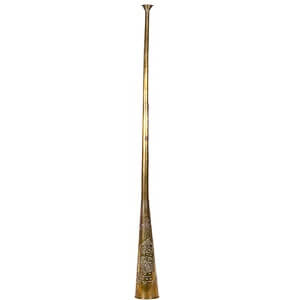Kakaki
 Kakaki, end-blown trumpet. The instrument consists of a straight metal tube formed from five sections welded together. The conical bell at the distal end terminates in a flat rim. There is embossed dog-tooth decoration below the rim and a boss where the bell joins the body. A straight, overlapping seam is visible down the side of the bell. Two bands of narrow cord are wrapped around the body just below the centre point. The top of the pipe has a slight conical expansion towards the proximal end. The integral mouthpiece consists of a flat disc attached to the proximal rim.
Kakaki, end-blown trumpet. The instrument consists of a straight metal tube formed from five sections welded together. The conical bell at the distal end terminates in a flat rim. There is embossed dog-tooth decoration below the rim and a boss where the bell joins the body. A straight, overlapping seam is visible down the side of the bell. Two bands of narrow cord are wrapped around the body just below the centre point. The top of the pipe has a slight conical expansion towards the proximal end. The integral mouthpiece consists of a flat disc attached to the proximal rim.
The kakaki is a signifier of royal or aristocratic status in many Islamic cultures of West Africa. Its origins lie with the Hausa people, but the spread of Hausa influence to neighboring cultures in the 19th century led to the wider adoption of the instrument, and it is now also closely associated with Fulani emirs. The use of the kakaki varies between these cultures, but they are usually used in groups of at least four, accompanied by cylindrical ganga drums and occasionally with the algaita, the most common oboe of West Africa. The pitches and rhythms performed by the kakaki imitate those of speech. The group consists of a soloist and an ensemble who alternate in statement and response intoning a text, known as a take, in praise of the group's patron.